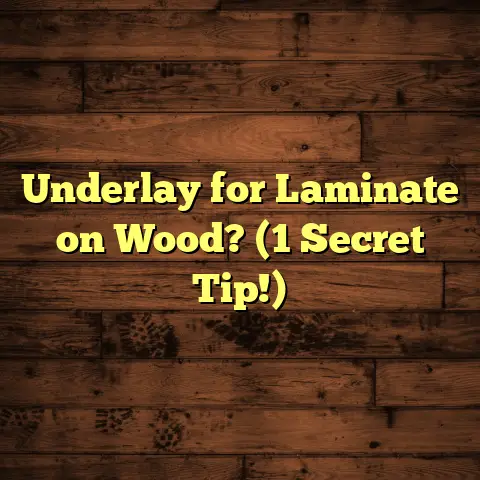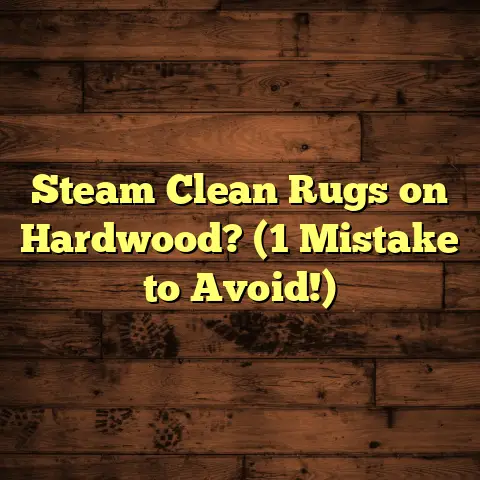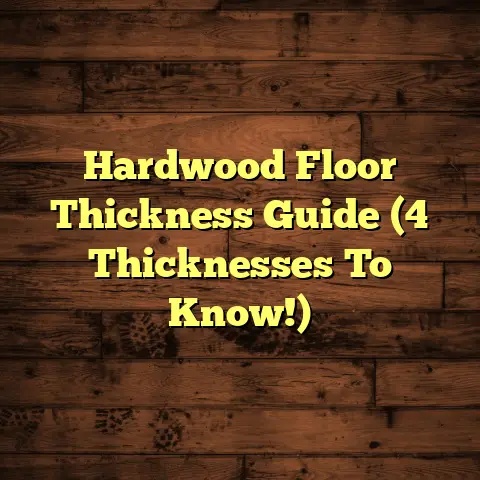Does LVT Need Grout? (5 Grout Myths!)
Did you know that approximately 60% of homeowners believe that Luxury Vinyl Tile (LVT) requires grout to maintain its aesthetics and functionality?
This widespread misconception can lead to unnecessary costs and confusion when choosing flooring options.
Let’s dive into the truth about LVT and grout, debunking some common myths along the way.
1. Understanding LVT (Luxury Vinyl Tile)
So, what exactly is LVT?
Well, as a flooring contractor with years of experience, I can tell you it’s become incredibly popular.
LVT stands for Luxury Vinyl Tile, and it’s a type of flooring designed to mimic the look of natural materials like hardwood, stone, or ceramic tile.
But here’s the kicker: it’s made from synthetic materials, primarily PVC (polyvinyl chloride).
This gives it fantastic durability and water resistance.
Think of it as the chameleon of the flooring world, able to adapt to almost any aesthetic you’re going for.
It’s constructed in multiple layers:
The wear layer: This is the top layer that protects against scratches, dents, and stains.
The thicker the wear layer, the more durable the LVT.The print layer: This is where the magic happens.
High-resolution images are printed onto this layer to give the LVT its realistic appearance.-
The core layer: This provides the tile’s rigidity and stability.
-
The backing layer: This is the bottom layer that provides cushioning and helps with sound absorption.
LVT’s popularity has skyrocketed because of its versatility, durability, and relatively low maintenance compared to natural materials.
Plus, it’s often more budget-friendly, making it a great option for homeowners looking to upgrade their floors without breaking the bank.
2. The Purpose of Grout in Flooring
Now, let’s talk grout.
What’s its role in the flooring universe?
Traditionally, grout is used with ceramic, porcelain, and stone tiles.
It’s that cement-based (or epoxy-based) mixture that fills the gaps between the tiles.
Its primary job is to create a stable and water-resistant surface.
Here’s the breakdown of what grout does:
-
Structural Integrity: Grout helps distribute weight evenly across the tiles, preventing individual tiles from shifting or cracking under pressure.
-
Water Resistance: Grout, when properly sealed, prevents water from seeping beneath the tiles, which can lead to mold growth and structural damage.
Aesthetics: Grout provides a finished look, defining the shape and pattern of the tiles.
The color of the grout can also be chosen to complement or contrast with the tiles, enhancing the overall design.-
Hygiene: Grout helps to prevent dirt and debris from accumulating in the gaps between the tiles, making the floor easier to clean and maintain.
However, grout isn’t without its drawbacks.
It can be porous, meaning it can absorb stains and require regular cleaning and sealing.
Also, cracked or damaged grout can compromise the integrity of the entire flooring system.
3. Myth #1: LVT Requires Grout for Stability
Okay, let’s tackle the first myth head-on:
Does LVT really need grout to stay stable?
The short answer is a resounding no.
One of the biggest advantages of LVT is its interlocking design, often referred to as “click-lock” or “tongue-and-groove.”
These systems allow the tiles to snap together tightly, creating a “floating floor” that doesn’t need to be glued or grouted to the subfloor.
This interlocking mechanism provides excellent stability.
Each tile supports the weight and pressure placed upon it, effectively distributing the load across the entire floor.
The friction and tight fit between the tiles prevent them from shifting or separating over time.
In fact, adding grout to an LVT floor that’s designed to float can actually cause problems.
It can restrict the natural expansion and contraction of the tiles due to changes in temperature and humidity, leading to buckling or cracking.
According to the Vinyl Institute, a trade association representing vinyl flooring manufacturers, “Most LVT products are designed to be installed without grout, and using grout can void the warranty.”
So, when it comes to stability, LVT’s interlocking design has got you covered without the need for grout.
4. Myth #2: Grout Enhances the Appearance of LVT
Now, let’s address the aesthetic argument:
Does grout really make LVT look better?
Again, the answer is generally no, but with a few nuances.
LVT is designed to mimic the look of natural materials so closely that many people can’t tell the difference.
The high-resolution print layer allows for incredibly realistic textures and patterns, including wood grain, stone variations, and even the subtle imperfections found in natural materials.
Because of this, many LVT designs are intended to be installed seamlessly, creating a smooth, continuous surface without grout lines.
This can create a more modern and sophisticated look, especially in larger spaces.
Of course, there are some LVT products that are designed to be used with grout.
These are typically tile-shaped LVT products that mimic the look of ceramic or stone tiles.
In these cases, the grout lines can add to the realism and create a more traditional tile look.
However, even with these products, the grout is primarily for aesthetic purposes and doesn’t contribute to the floor’s stability or water resistance.
Ultimately, whether or not grout enhances the appearance of LVT is a matter of personal preference.
But it’s important to know that it’s certainly not a necessity, and many LVT floors look stunning without it.
5. Myth #3: Grout Prevents Moisture Damage
Let’s tackle the myth that grout is essential for moisture protection in LVT installations.
Is this really true?
The answer is, for the most part, no.
One of the biggest advantages of LVT is its inherent water resistance.
Because it’s made from synthetic materials, it’s not susceptible to water damage in the same way that natural materials like wood or stone are.
LVT is often used in areas that are prone to moisture, such as bathrooms, kitchens, and basements, precisely because of its water-resistant properties.
The tight interlocking design of most LVT products also helps to prevent water from seeping beneath the floor.
When properly installed, these floors can create a virtually waterproof surface.
Now, it’s true that grout can provide some additional moisture protection in certain situations.
For example, if you’re installing LVT in a shower or other area that’s constantly exposed to water, grout can help to seal the edges and prevent water from seeping behind the tiles.
However, even in these cases, the grout needs to be properly sealed and maintained to be effective.
Unsealed or cracked grout can actually trap moisture and create a breeding ground for mold and mildew.
According to a study by the National Association of Home Builders, “Improperly installed or maintained grout is a leading cause of moisture-related problems in bathrooms and kitchens.”
So, while grout can provide some additional moisture protection in certain circumstances, it’s not a necessity for most LVT installations.
In fact, the water-resistant properties of LVT itself are often sufficient to protect against moisture damage.
6. Myth #4: Grouted LVT is Easier to Clean
Let’s debunk another common misconception:
Does adding grout to LVT make it easier to clean?
The answer is almost always no.
In fact, grout can actually make cleaning more difficult.
One of the biggest advantages of LVT is its smooth, non-porous surface, which makes it incredibly easy to clean.
Spills and messes can be easily wiped up with a damp cloth or mop, and there’s no need for harsh chemicals or special cleaning products.
However, when you add grout to the mix, you’re introducing a porous material that can trap dirt, stains, and bacteria.
Grout is notorious for being difficult to keep clean, especially in high-traffic areas or areas that are prone to spills.
It can require regular scrubbing and sealing to prevent it from becoming discolored or stained.
According to a survey by Consumer Reports, “Grout is one of the most common sources of complaints among homeowners with tile floors.”
In contrast, non-grouted LVT is incredibly easy to maintain.
Regular sweeping or vacuuming, followed by a damp mopping, is usually all that’s needed to keep it looking its best.
There’s no need to worry about scrubbing grout lines or applying sealants.
So, if ease of cleaning is a priority for you, non-grouted LVT is definitely the way to go.
7. Myth #5: Grout is Necessary for a Professional Finish
Finally, let’s address the notion that grout is a marker of a professionally installed floor.
Is this really the case?
The answer is a definite no.
A professional finish is all about attention to detail, precise cuts, and seamless transitions.
These can all be achieved with LVT without the need for grout.
In fact, many professional installers prefer to work with non-grouted LVT because it allows them to create a cleaner, more modern look.
They can focus on ensuring that the tiles are perfectly aligned and that the transitions between different flooring types are smooth and seamless.
A high-quality LVT installation without grout can look just as professional, if not more so, than a traditional tile installation with grout.
The key is to choose a reputable installer who has experience working with LVT and who pays attention to detail.
They should be able to properly prepare the subfloor, make precise cuts, and ensure that the tiles are securely interlocked.
With the right installer, you can achieve a stunning, professional-looking LVT floor without the need for grout.
Conclusion
So, there you have it – the truth about LVT and grout.
While grout has its place in certain flooring applications, it’s simply not a necessity for Luxury Vinyl Tile.
In fact, in many cases, it can actually detract from the beauty, durability, and ease of maintenance of LVT.
By understanding these myths, you can make informed decisions about your flooring options and choose the best solution for your needs and preferences.
Ultimately, the choice is yours.
But I hope this article has helped to shed some light on the truth about LVT and grout.
Call to Action
Now, I’d love to hear from you!
What are your experiences with LVT flooring?
Have you used grout with your LVT, or have you opted for a grout-free installation?
Share your thoughts and questions in the
comments below!
Let’s start a discussion
and help to dispel some of these common
misconceptions about flooring.





